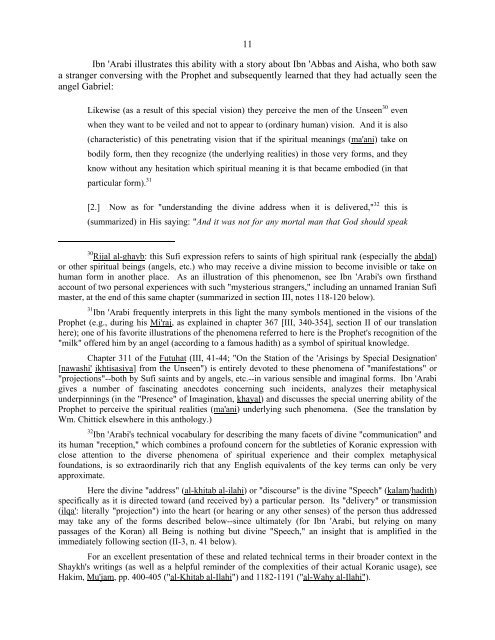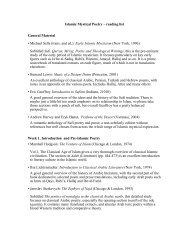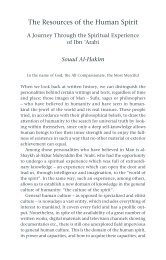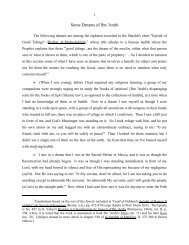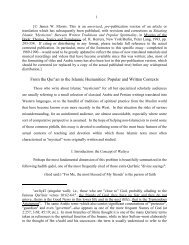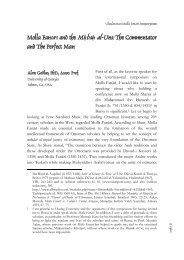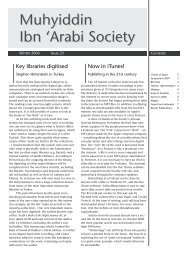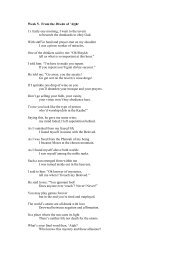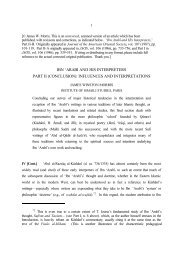The Mahdi and His Helpers - Muhyiddin Ibn Arabi Society
The Mahdi and His Helpers - Muhyiddin Ibn Arabi Society
The Mahdi and His Helpers - Muhyiddin Ibn Arabi Society
You also want an ePaper? Increase the reach of your titles
YUMPU automatically turns print PDFs into web optimized ePapers that Google loves.
11<strong>Ibn</strong> '<strong>Arabi</strong> illustrates this ability with a story about <strong>Ibn</strong> 'Abbas <strong>and</strong> Aisha, who both sawa stranger conversing with the Prophet <strong>and</strong> subsequently learned that they had actually seen theangel Gabriel:Likewise (as a result of this special vision) they perceive the men of the Unseen 30 evenwhen they want to be veiled <strong>and</strong> not to appear to (ordinary human) vision. And it is also(characteristic) of this penetrating vision that if the spiritual meanings (ma'ani) take onbodily form, then they recognize (the underlying realities) in those very forms, <strong>and</strong> theyknow without any hesitation which spiritual meaning it is that became embodied (in thatparticular form). 31[2.] Now as for "underst<strong>and</strong>ing the divine address when it is delivered," 32 this is(summarized) in <strong>His</strong> saying: "And it was not for any mortal man that God should speak30 Rijal al-ghayb: this Sufi expression refers to saints of high spiritual rank (especially the abdal)or other spiritual beings (angels, etc.) who may receive a divine mission to become invisible or take onhuman form in another place. As an illustration of this phenomenon, see <strong>Ibn</strong> '<strong>Arabi</strong>'s own firsth<strong>and</strong>account of two personal experiences with such "mysterious strangers," including an unnamed Iranian Sufimaster, at the end of this same chapter (summarized in section III, notes 118-120 below).31 <strong>Ibn</strong> '<strong>Arabi</strong> frequently interprets in this light the many symbols mentioned in the visions of theProphet (e.g., during his Mi'raj, as explained in chapter 367 [III, 340-354], section II of our translationhere); one of his favorite illustrations of the phenomena referred to here is the Prophet's recognition of the"milk" offered him by an angel (according to a famous hadith) as a symbol of spiritual knowledge.Chapter 311 of the Futuhat (III, 41-44; "On the Station of the 'Arisings by Special Designation'[nawashi' ikhtisasiya] from the Unseen") is entirely devoted to these phenomena of "manifestations" or"projections"--both by Sufi saints <strong>and</strong> by angels, etc.--in various sensible <strong>and</strong> imaginal forms. <strong>Ibn</strong> '<strong>Arabi</strong>gives a number of fascinating anecdotes concerning such incidents, analyzes their metaphysicalunderpinnings (in the "Presence" of Imagination, khayal) <strong>and</strong> discusses the special unerring ability of theProphet to perceive the spiritual realities (ma'ani) underlying such phenomena. (See the translation byWm. Chittick elsewhere in this anthology.)32 <strong>Ibn</strong> '<strong>Arabi</strong>'s technical vocabulary for describing the many facets of divine "communication" <strong>and</strong>its human "reception," which combines a profound concern for the subtleties of Koranic expression withclose attention to the diverse phenomena of spiritual experience <strong>and</strong> their complex metaphysicalfoundations, is so extraordinarily rich that any English equivalents of the key terms can only be veryapproximate.Here the divine "address" (al-khitab al-ilahi) or "discourse" is the divine "Speech" (kalam/hadith)specifically as it is directed toward (<strong>and</strong> received by) a particular person. Its "delivery" or transmission(ilqa': literally "projection") into the heart (or hearing or any other senses) of the person thus addressedmay take any of the forms described below--since ultimately (for <strong>Ibn</strong> '<strong>Arabi</strong>, but relying on manypassages of the Koran) all Being is nothing but divine "Speech," an insight that is amplified in theimmediately following section (II-3, n. 41 below).For an excellent presentation of these <strong>and</strong> related technical terms in their broader context in theShaykh's writings (as well as a helpful reminder of the complexities of their actual Koranic usage), seeHakim, Mu'jam, pp. 400-405 ("al-Khitab al-Ilahi") <strong>and</strong> 1182-1191 ("al-Wahy al-Ilahi").


